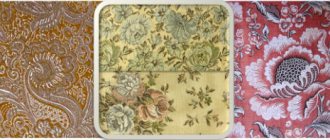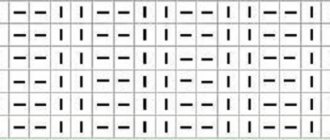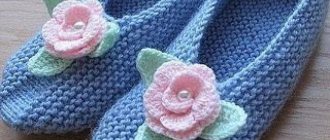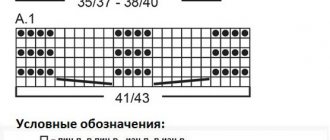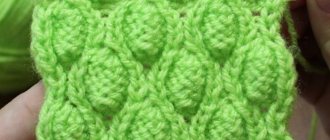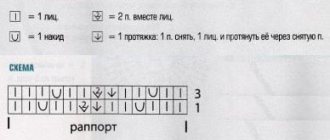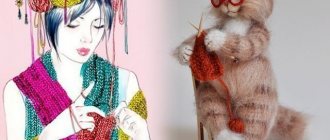Yarn for slippers
Knitted slippers must be not only beautiful and warm, but also comfortable to wear, otherwise they will not be able to fully please their owner.
The comfort of a knitted product largely depends on the yarn, so when choosing it you need to take into account some important nuances:
- To make the product as warm as possible, it is important to pay attention to the composition of the yarn . Experienced knitters recommend choosing natural wool and wool blend threads for socks and slippers. Products made from them are very warm, breathable, and also the most durable.
- The second important parameter is yarn thickness . If you choose a thin thread, the slippers will not be warm; if the yarn is too thick, the product may not be very comfortable to wear. The best option is threads of medium thickness: 200-300 m / 100 g. You can also take thinner yarn, but in this case knit the product in 2-3 folds of thread.
- If slippers are to be knitted for a child, you should give preference to special children's yarn , because... it is hypoallergenic, has a safe composition and is very pleasant to the touch.
- The choice of the color of the product always remains with the craftswoman, but if the slippers will be knitted from various leftover yarns, it is very important that they not only match in color, but also be approximately the same thickness and texture. If this simple rule is not followed, the knitted fabric may turn out uneven and sloppy.
Fluffy patterns
To make knitting such a simple product more interesting, you can combine yarn of different colors or use different patterns in knitting.
For example, footprints knitted with a herringbone pattern. They are easy to knit and look very impressive.
A description and detailed instructions for knitting these wonderful leopards are offered in the video.
Beautiful and very feminine footwear with a knitted “leaves” pattern. They knit very simply and quickly. Even a novice craftswoman can knit them without difficulty.
Related article: We sew a wallet with our own hands for a boy
For knitting these tracks, a MK video is offered:
People have long appreciated this item of clothing. Knitted from soft, bulky yarn, they have long replaced slippers for many. If you knit them from cotton with an openwork pattern, you will get lace summer heels. And if you glue a thin sole to the footwear knitted from linen yarn, you will get wonderful summer ballet shoes or moccasins.
Made from natural wool, they not only provide warmth, but also acquire healing properties. Wool itself produces a micro-massage if you wear it on your bare foot. And if you add dry mustard to the traces and leave them on your feet overnight, you can use them to cure a cold.
And when it comes to recycling leftover yarn, these socks have no equal. Multi-color options for their execution only make the tracks more interesting.
What sole to choose (make) for slippers
The soles of slippers can be made of various materials. The simplest and most common option is a sole knitted from the same or denser yarn as the slippers.
For strength, many needlewomen add another thread to the main thread when knitting it.
If a more wear-resistant option is required, the sole can be made of felt or thick leather. Its shape is easiest to cut out using a suitable insole. The sole can be made separately and then tied or sewn to the finished product.
Knitting needles
To knit socks and slippers, craftswomen use special stocking needles, which are sold in the form of a set of 5 pieces. They differ in the material of manufacture (metal, wood, plastic) and diameter (marked with numbers).
The material from which the knitting needles are made is not fundamentally important, it is a matter of personal preference.
The number of knitting needles is selected depending on the nature of the product and the thickness of the selected threads. For knitting slippers and socks, it is recommended that the diameter of the knitting needles approximately coincides with the thickness of the thread; in this case, knitting will be as comfortable as possible, and the fabric will be dense, even and beautiful. For example, for yarn 250-300 m/100 g, knitting needles No. 2.5-3 are optimal.
Additional accessories for knitting slippers
In addition to yarn and knitting needles, when creating knitted shoes you may need:
- knitting markers (special plastic hooks used to highlight stitches during calculations);
- hook (with its help it is convenient to hide the “tails” of cut threads, as well as to tie the edges of finished products);
- thick needle with a wide eye (for sewing products).
All of these knitting supplies can be purchased at craft stores along with yarn and knitting needles. Women's and children's slippers, knitted by hand, can be complemented with accessories that will make the item more interesting, beautiful and unique in its own way.
For this purpose use:
- decorative buttons;
- beads;
- crocheted flowers;
- bows and ribbons;
- pompoms, etc.
Simple slippers on two knitting needles
This simple model of slippers can be knitted on two knitting needles in literally a couple of hours; the proposed pattern is an ideal option for beginning needlewomen: it will help you “teach” your hand and will delight you with its original appearance. Calculations are given for foot size 38-39.
Necessary materials
Scroll:
- Yarn (300m/100g) – 1 skein.
- Knitting needles No. 3.
- Knitting markers.
- Needle for stitching.
- Additional accessories.
Sequence of work
Performance:
- You need to cast on 63 stitches on the knitting needles. The first row is performed with a classic 1/1 elastic band.
- The central loop (33rd) is marked with a knitting marker. Start from row 2 (then in all purl rows), you should make increases: yarn over in front of the loop in the center and immediately after it, knit them from the front side as crossed. Continue to knit according to the pattern with an elastic band and increase until the total number of stitches reaches 85.
- On the left side of the product, remove it onto an auxiliary knitting needle of 44 sts and put it aside temporarily. They begin to form the sole: on the right side, close 4 stitches at the beginning of the row, knit 7 cm in height with garter stitch.
- Moving on to assembly. Transfer the loops from the auxiliary needle to the working one. Moving from toe to heel, sew loops from both knitting needles with a needle (loop-to-loop stitch). The remaining 5 stitches are closed. Perform a side seam. Sew the heel, connect the toe.
- If desired, the upper part of the product can be crocheted, and you can also decorate the finished tracks with additional accessories.
Children's slippers
Cast on 30 stitches, then knit according to the pattern:
1−6 rub. for the plank - faces. loops;- 7−22 rub. - knit odd rows of faces. loops, even - purl;
- 23−45 rub. - form a heel, for which knit 19 knit stitches, 21, 20 and 21 knit stitches together, turn the product over;
- 9 purl, 10−11 purl together, turn the product;
- 9 knits, 10−11 knits together;
- alternate rows (front, back) until 10 stitches remain. The heel is ready.
For the foot, cast on 10 stitches from the sides of the heel. On one side, knit 20 stitches, pick up 10 stitches, on the other side, until there are 30 stitches in the work. Next, knit 31 rows of faces. satin stitch For the sock, decrease from about row 5.
See in the figure what the decreases look like. Next, you can start knitting the top of the trail to cover the top, thereby picking up 1 loop from the sides of the knitting in each row. Scheme:
- 84 rub. - 9 purl, 10 p. knit from the side;
- 85 rub. - knit 4, knit 3 together, knit 3, knit 1 p. from the side;
- 84−85 rub. - repeat until the loops are closed, picking up 16-18 loops on each side. Children's slippers are ready.
Slippers with two knitting needles made of rectangle
This original model of slippers is reminiscent of oriental shoes in appearance, and it is very easy to knit it on two knitting needles, because while working you don’t even need to make any increases or decreases according to the pattern. The base is a rectangle knitted in garter stitch (all rows are performed only with knit stitches).
Such tracks made from sectionally dyed yarn look most impressive , but they can be knitted from plain threads or from multi-colored leftovers.
To work you will need:
- Yarn (250 m/100g) – 1 skein.
- Knitting needles No. 3.
- Needle.
- Hook.
Sequence of work
Performance:
- First of all, they perform calculations so as not to make a mistake with the size of the slippers. Measure the length of the foot, multiply by 2 - this is the required width of the rectangle. From the yarn you like, knit a test sample of 10 stitches, measure it and calculate the required number of loops for the resulting width.
- Based on the resulting calculations, cast on the loops on the knitting needles, make a rectangle 12 cm high with garter stitch. Close the loops, use a hook to process the top in any convenient way - columns, picots or “shells”.
- Fold the rectangle in half, form a toe by folding the edges of the product into a cone shape. Sew along the sole line.
Knitted footwear with knitting needles with patterns and descriptions
How is leopard knitting done? Let's look at a simple example of homemade socks, step-by-step instructions:
- If the leg is small, you need to cast on 40-50 loops. Then continue with 3 rows of garter stitch.
- When the side is completed, divide the total quantity into 2 parts, mark the middle odd one for yourself with a marker.
- Yarn over in front of the center loop, knit and make the next part of the yarn over.
- The sock is knitted according to the depth, so you need to try it on periodically to get it to fit.
- You need to add another 5-8 stitches to the sole on each side. 11 stitches in a row are knitted together with one of the side rows.
- The finished piece is turned over, and a row of side loops to the plantar loops is made purlwise.
- Backdrop: loops on the sides need to be knitted together. After this stage, the product is ready.
Children's footwear knitting needles
Little feet must be kept warm. Slippers on two knitting needles without a seam for kids are very relevant in the cold season: they are suitable for home, kindergarten, as an alternative to slippers when visiting. You will not need to worry about the floor temperature, because thanks to such slippers, the warmth for your feet is well retained. How to knit footwear for a child, step-by-step master class:
- For warm knitted socks, it is better to take natural threads and knitting needles (size 3 or 4). Cast on 36 loops, distributing them into 3 parts as you work: knit 12 (knit), then purl 1 (p), 10 knit. 1 purl, 12 l. Work with this knitting for 14-15 cm.
- Tie 10 cm with elastic band 1*1 (1 p., 1 p.).
- Reduce the quantity by half: on the front side, knit two as one, on the wrong side, knit as before. Repeat this action again and tighten the thread in the loop.
- We use the remaining thread to tighten the trace (it is better to use a hook). If desired, you can make a sock with a pattern, braids, or yarn of several colors. Neat knitted footprints are ready!
Women's heels on two knitting needles
Beautiful knitted footprints for women's legs never hurt. Knitting footwear for girls, step-by-step diagram:
- The work is carried out using knitting needles of 3 sizes from natural wool yarn. For knitting you will need 2 skeins of thread of 100 grams each.
- Cast on 13 sts and work 8 rows in garter stitch.
- From the 9th row, make an increase like this: 1 edge stitch, 5 garter stitches, yarn over, 1 stitch, another yarn over, again 5 garter stitches and the final edge stitch. Knit the wrong side according to the result obtained, with the yarn overs crossed on the wrong side.
- Next, we replenish the front rows with additional yarn overs before and after garter stitch. Wrong side - according to the drawing, yarn overs - crossed wrong side. Continue this knitting until you get 39 loops.
- From the total number, select the central 9 stitches, make a rounding on the toe: knit 15, 9 and 10 together. Turn the fabric: knit 8, again 9 and 10 together. So for now there will only be 9 central loops left.
- Along the edge of the toe, pick up 18 pieces of edging on both sides. The resulting loops are now 45. Distribute as follows: edge loop, 5 scarf stitches, 1 purl loop, 4 harness loops, purl stitch, 21 l. Then purl 1, purl 4, purl stitch, garter stitch 5, edge stitch.
- In plaits, shift the pattern every 4th row: leave 2 on the auxiliary needle, knit two, then pick up the remaining 2. Knit the wrong side according to the resulting pattern. Complete 37-40 rows (for foot size 37).
- Knit the heel according to the toe principle.
- The final 8 rows are garter stitch. At the end, knit a row, closing all the loops - the product is ready. The slippers can be decorated with beads, bows, and flowers.
Knitted men's slippers
This model of slippers is not new, but it is popular and very practical. How to make a beautiful product for the winter for a man to protect his feet from the cold? Step-by-step lesson for beginning needlewomen:
- On a not very large leg it will be knitted like this: cast on 53 stitches, knit 4 rows in garter stitch.
- Next, on the 5th front row, mark the central loop with a marker. We knit the first 25 with any elastic band. The 25th loop must be a knit stitch; after the edge stitch, immediately knit 1 purl, then knit, etc. After the elastic: yarn over (n.), knit (l.), then n., l. central, n., l., n. Then the elastic band, which we start with the front one.
- Instructions for rows: 6 and purl all – rib all over the fabric, and purl the loops and yarn overs. 7th row – 25 loops with an elastic band, yarn over (n.), 3 l., n., front central yarn over, 3 l., n., 25 with an elastic band. Row 9 - like the seventh, but there are no 3, but 5 knit stitches, except for the central one. Row 11 is like the seventh, but knit not 3, but 7, except for the middle loop.
A few more secrets:
- You need to knit until the fabric takes the shape of a corner, and the number of loops between the yarn overs reaches 19 pieces. Then 4 rows in garter stitch and tighten the thread.
- On a free knitting needle we remove without knitting a loop until the 9 central ones remain on the knitting needle on the left.
- We knit 8 stitches, then 9 and 10 together.
- The work at this stage needs to be turned: 8 l., 9 and 10 together, after turning the same.
- We knit about 30 rows, try it on the leg and start making the toe of the heel with either an elastic band or garter stitch. At this time, all parts of the sole and sides should be tied.
Learn how to knit socks by watching step-by-step instructions with photos and videos.
- Megafon call printout for free. How to make a call printout Megafon
- Scottish cat straight and fold
- Fine for driving without insurance
Men's knitted moccasin slippers
Men's slippers, reminiscent of moccasins, are knitted on two needles according to the given pattern quite easily and quickly, but at the same time they look very original. The calculations given correspond to sizes 40-41. The entire product is made in simple garter stitch, that is, in all rows the loops are always knitted only with knit stitches.
To make them you will need:
- Medium thickness yarn – 80 g.
- Knitting needles No. 3.
- Hook for decorative processing.
Sequence of work
Performance:
- Cast on 48 stitches , the first 4 rows are done in garter stitch.
- 5-6 rows. Additions are made according to the following principle: chrome, 1 l. p., 1 yarn over, *4 l. p., yarn over*, repeat from * to* until the end of the row. Taking into account the additions on the knitting needles, the result is 60 sts. From the wrong side, yarn overs should be knitted behind the back wall.
- 7-26 r. Performed using garter stitch.
- Start forming the sole. Using knitting markers, mark the middle 10 stitches. Knit the first 24 stitches, knit the next two stitches simultaneously, then the central 10 stitches and one side stitch. Turn the work to the wrong side, the first two loops are knitted simultaneously, the next 8 stitches are knitted, the outermost of the central ones and the first of the cast-on part are knitted together again, the work is turned to face. Continue to decrease according to this principle until all the side loops are closed; only the central ones should remain on the knitting needles.
- Knit the heel. From the edge loops, pick up 13 stitches on both sides of the remaining stitches, 36 stitches on the knitting needles. Performed in garter stitch 26 r. Continue to work with decreases in the front rows: knit two loops at the same time at the beginning and end of the row, as a result, only 10 central loops should remain on the knitting needles.
- The toe is formed: on the right and left sides of the remaining stitches on the knitting needles, 25 stitches are cast on from the edge stitches. Next, the toe is formed in the same way as the heel. Knit 10 central loops, knit the outer one together with the first of the cast-on row, turn the work. The central loops are knitted, the outermost one is also knitted simultaneously with the first one from the side row. Continue working, only 10 stitches should remain on the knitting needles again. They need to be closed.
- Crochet the outline of the toe (single crochets), decorate as desired. The second slipper is knitted in the same way as the first.
Simple step-by-step instructions
Even a beginner in this matter can knit tracks with knitting needles. Relatives and friends will definitely appreciate the handicraft it deserves. In addition, beautiful knitted footprints on knitting needles are a handmade gift, for example, for the New Year holidays or Christmas.
It’s worth starting work by measuring the length of the foot, since it is the size that needs to be taken into account when casting the required loops. The main thing is that the number is odd. We also must not forget that when knitting (regardless of the row), the first loop is always removed, and the last one is knitted purl-wise.
It is better to start knitting leopards on 2 knitting needles (the description is simple) with wool yarn in 2 folds . You will need:
- yarn - 100 g;
- knitting needles number 3.
Cast on 13 sts and knit 8 rows using the rasp pattern. Further:
- 9 r: selvedge, 5 sts in garter stitch, yarn over, knit, yarn over again, 5 sts in garter stitch, edging;
- turn over to the wrong side, follow the pattern, knitting the yarn overs crossed;
- in the front rows, knit a yarn over “before” and “after” garter stitch, thereby expanding the fabric until 39 stitches appear on the knitting needles;
- count 9 loops in the middle (this will be the toe), to do this, knit: 15 stitches, 2 stitches together, unfold the fabric, knit 8-10 stitches, 2 stitches together, turn the product over. Knit in this way until only 9 main stitches remain on the knitting needles in the center;
- then cast on 18 stitches along the edge on both sides of the fabric. 45 stitches should be formed on the knitting needles, with the calculation that the last 1 is the edge stitch;
- 5 p. scarf, purl, 4 p. tourniquet, 21 knits;
- purl, 4 harness loops, purl, 5 plates, edge;
- knit forward and backward, shifting the pattern every fourth row.
Knit 38-40 r, leaving 2 sts on an additional needle. When knitting the strands in the next purl row, pick up 2 reserve loops, knitting according to the pattern.
Knit the heel as well as the toe. Next, knit another 8 p. garter stitch, then bind off the stitches according to the pattern.
The result is a very nice model. You can add bows or add original beads.
Slippers with two knitting needles without seam
The most comfortable for adults and children are socks and slippers knitted on two knitting needles using a seamless pattern: they fit snugly to the foot without causing discomfort when worn. Seamless slippers are also beneficial because they can be worn not only at home, but also worn under shoes in cold weather .
The master class presents calculations for foot sizes 36-38.
Prepare materials:
- Yarn (250 m/100g) – 1 skein of main color, 50 g of finishing yarn in contrasting color;
- Knitting needles No. 3.
Sequence of work
Performance:
- The main yarn is cast on 47 sts on knitting needles. Rows 1-6 are performed with a standard elastic band (chrome, 1 sp, 1 st).
- Find and mark the center (24th stitch) with a knitting marker. Continue working with the finishing thread: chrome, *1 sp, 1 lp, 1 sp, 1 st transferred to a knitting needle (do not knit, thread at work) * - then repeat from * to * to the center. A yarn over is made in front of the marked loop, the central one is removed, another yarn over is made, and the row is completed by analogy with the first half. The wrong side must be knitted the way the pattern looks, the removed loops are also transferred (not knitted), the thread is left before work. Yarn overs are also made before and after the central loop, while the yarn overs from the previous knit row are knitted with a crossed knit stitch.
- Switch to the main yarn again: chrome, * 1 i.p., 1 l.p. move (thread at work), 1 and. p., 1 l. p. * - repeat from * to * to the center. The central loop is knitted, and yarn overs are also made before and after it. Knit to the end of the row according to the same pattern. The purl row is performed in the same way as the previous one.
- According to the described principle, 14 subsequent rows are repeated, alternating the main and finishing threads.
- Proceed to knitting the sole: count off the middle 15 stitches and mark with markers. Knit the main yarn with an elastic band according to the pattern up to the central 15 stitches. They are also knitted with an elastic band, the outermost loop and the first of the side row are knitted at the same time. The work is unfolding. Knit 14 stitches according to the pattern, the outermost loop is knitted simultaneously with the first from the side row, then the work needs to be unfolded again. Continue to knit according to this principle, in the end only 15 stitches should remain on the knitting needles.
- Heel. On both sides of the central 15 sts, 16 sts are picked up from the edge stitches. The heel is formed according to the same principle as the sole, i.e. you need to knit two loops at the same time from each edge until only 15 stitches remain on the knitting needles again. Close the loops. Using a hook, hide the tails of the cut threads, decorate as desired.
Two-tone slippers
Using stocking needles, you can create not only single-color, but also two-color slippers that will please the eye and keep you warm during the cold season.
Step-by-step instruction:
- Initially, an odd number is collected.
- Rows from the ankle to the base of the heel are made using the scarf method.
- Next, count exactly half of the loops and place a colored odd thread.
- Next, we decorate with the garter stitch method, making two casts each: the first is done before the central loop, the second after it.
- Next, the product is knitted using the stocking method for six rows.
- After this, we switch to the scarf again.
- We decrease four loops every other row.
- Using the decreasing method we make eight more rows.
- The last one is closing.
- The panel is folded in half and joined using a pin seam.
Useful video
Share this post
- Related Posts
- Step-by-step instructions on how to sew Roman blinds for the kitchen from fabric, wallpaper and blinds with your own hands
- How and where to apply for divorce and what documents are needed?
- How to clean the inside of an iron from scale?
- Orthodox canons for funerals of a person on the 3rd day after death
- Combination of colors with blue in clothing and interior
- Where to go for a seaside holiday in May?
Children's slippers with two spokes
In winter and autumn, it is especially important to ensure that children’s feet are always warm – both at home and outside. Foot slippers will ideally cope with this task, and besides, they can be knitted according to the given pattern on two knitting needles literally in one evening. Calculations are given for slippers for a child up to one year.
For knitting you will need:
- Children's wool or acrylic yarn - 60 g of the main color, 30 g of another color for finishing.
- Knitting needles No. 3.
- Hook.
Sequence of work
Performance:
- With the main yarn, pick up the initial row of 25 stitches, perform 2 rows. garter stitch.
- Finishing yarn is used to knit the next 2 rows. garter stitch.
- Return to the main yarn, perform 2 more rows with the same pattern.
The knitting pattern for children's slippers on two knitting needles is shown in the photo. - 7-8 r. Mark the central loop with a marker, continue working with contrasting yarn according to the pattern: chrome, *1 l. p., 1 is transferred to the knitting needle (do not knit, the thread is at work) *, repeat to the center. 7 stitches are pulled out from the marked loop. The row is also completed according to the pattern from * to *. From the wrong side, the thrown loops are removed again, but the thread should now remain before work, the rest must be knitted with knit stitches (including 7 yarn overs from the central loop).
- Rows 9-10 should be knitted in garter stitch in the main color.
- The 11th row is knitted with finishing yarn: chrome, *1 is transferred to a knitting needle (thread at work), 1 l.p.*, 7 loops are also knitted from the central one.
- 12th row - knit according to the pattern, similar to 8 r.
- 13-14 r. – garter stitch with main yarn.
- 15-16 r.: knit according to the pattern 7-8 r.
- 17-18 r.: All loops are knitted with the main yarn.
- 19-20 r. – garter stitch in the main color.
- The rest of the work is continued with only the main color. Rows 21-25 are done in garter stitch.
- Row 26: 20 stitches need to be knitted, the next three central loops begin to close the sole: 2 stitches are knitted, the third loop is knitted simultaneously with the first side purl. The product is unwrapped. The first loop is removed, one is knitted, the third is knitted together with the first from the side row, and the work is unfolded again. Continue knitting like this until all the side loops are completed.
- The heel is formed: from the edge loops, 13 stitches are cast on both sides of the central ones. They are closed in the same way as the sole. Close the remaining central loops and hide the threads with a hook. The slippers are ready; if desired, the product can be decorated with additional accessories.
You can take any of the above patterns for knitting slippers on two knitting needles as the basis for your work, and vary the size depending on your needs, adding or subtracting the number of loops and rows.
The same can be said about the design of knitted slippers: color solutions, variations on patterns and decor have no restrictions. Knitting is a creative process that brings not only practical benefits, but also pleasure.
Men's footprints
Men will definitely appreciate the work if they knit warm slippers without seams that will not press or rub. Feet will always remain warm. Select:
- 2 knitting needles No. 3;
- yarn, 1 skein of any color.
Cast on 49 p., knit 3 r. elastic band (1x1). Knit 2-3 r. with an elastic band. Further:
- yarn over, knits., yarn over, knits., mark the central loop with a marker;
- yarn over, knit, yarn over again, knit 23 stitches with an elastic band;
- knit another 5 p. according to the garter knitting pattern, with the row following them only up to half;
- middle 7 stitches - with a scarf pattern, in this case it is necessary to knit 2 together at the end of the row.
Continue knitting up to 7 central loops. Cast on 14 stitches of elastic on both sides to form the heel part. Knit 2 together in each subsequent row. Close the loops. The tracks are ready.



